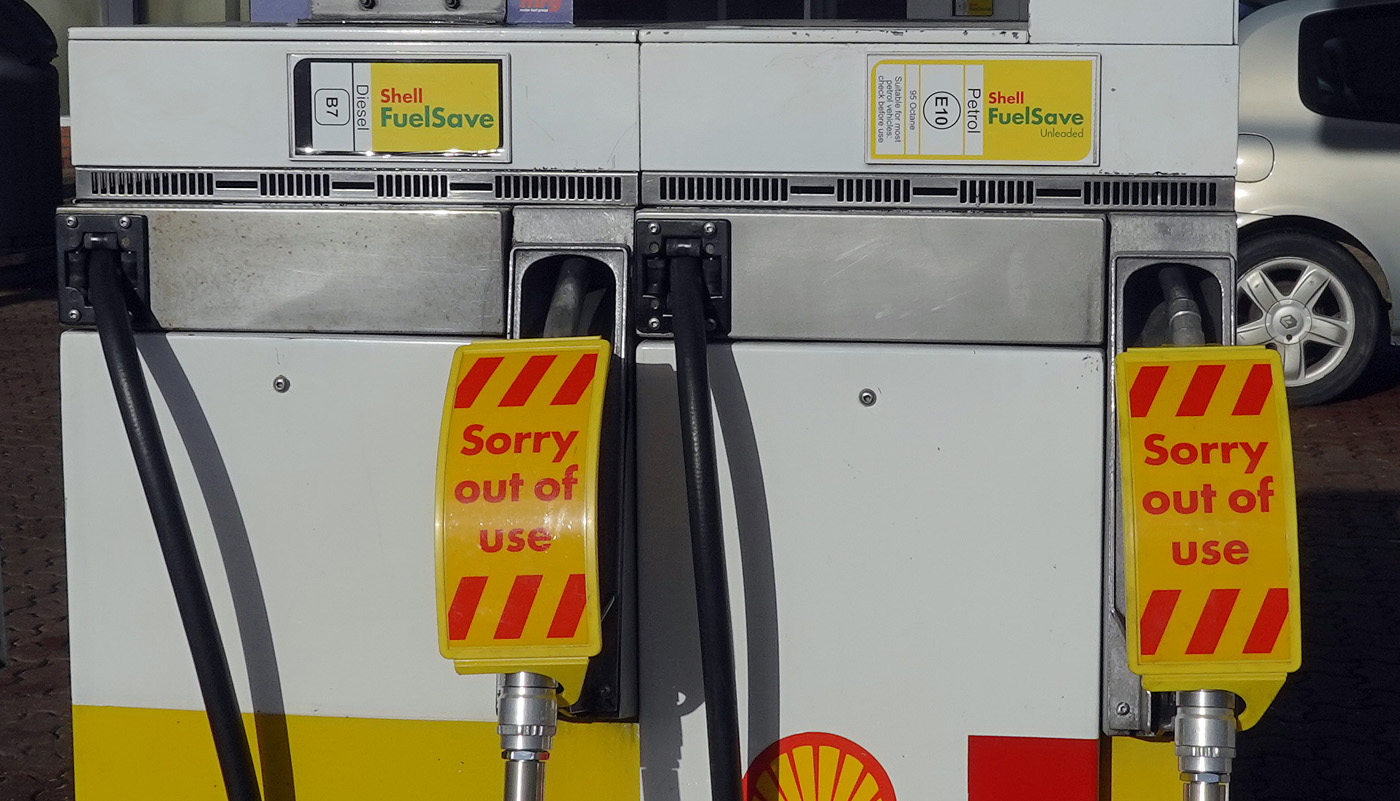 Long queues at petrol pumps, with many filling stations running out of fuel; fears of shortages of food and various other items in supermarkets; orders by shops and warehouses unfilled or delayed. These have been some of the headlines in the UK in recent days.
Long queues at petrol pumps, with many filling stations running out of fuel; fears of shortages of food and various other items in supermarkets; orders by shops and warehouses unfilled or delayed. These have been some of the headlines in the UK in recent days.
The immediate problem is a shortage of over 100 000 lorry drivers, with thousands of drivers from EU countries, who were previously living and working in the UK, having returned to their home countries. Their numbers have not been replaced by British drivers, a problem exacerbated by a decline in HGV tests during the pandemic. Thus the supply of lorry drivers has fallen.
At the same time, as the economy recovers from the COVID-19 pandemic, aggregate demand has risen and with it the demand for lorry drivers.
The shortage is pushing up wages somewhat, but not enough to eliminate the shortage. What is more, the supply of lorry drivers is relatively wage inelastic: a higher wage does not attract many more drivers into the market. Also the demand is also relatively wage inelastic: a higher wage does not do much to dampen the demand for drivers.
But why has this happened? Why has the supply of drivers fallen and why is it inelastic? And what will happen in the coming months? The three main causes are Brexit, COVID-19 and working conditions.
Brexit
 With Brexit, many EU workers left the UK, finding life and working conditions more conducive in the EU. Many EU drivers had faced discrimination and felt that they were not welcome in the UK. It has been difficult finding replacement drivers from the EU as the UK’s immigration system, which now applies to the EU as well as other countries, prioritises workers who are classified as high-skilled, and these do not include lorry drivers.
With Brexit, many EU workers left the UK, finding life and working conditions more conducive in the EU. Many EU drivers had faced discrimination and felt that they were not welcome in the UK. It has been difficult finding replacement drivers from the EU as the UK’s immigration system, which now applies to the EU as well as other countries, prioritises workers who are classified as high-skilled, and these do not include lorry drivers.
Those EU drivers who do want to stay as UK residents are finding that settled status or visas are not easy to achieve and involve filling in various documents, which can be an onerous and time-consuming process. As the writer of the first linked bog below, who is a Polish worker in the transport industry, states, ‘Would you rather come to Britain and jump through all the hoops, or choose any of the well-paying EU countries, for example, Germany that, if you live in Western Poland, is just a short drive across (virtually non-existent thanks to Schengen) border?’ Another problem is that with EU driving licences: it is harder for potential employers to check on their status and thus they may prefer to employ UK drivers. This, again, puts off EU drivers from seeking to stay in the UK.
Even in the case of EU drivers living in the EU but delivering to the UK there are problems. First there are the dangers for drivers of boarding ferries in France, where people from migrant camps seek to board lorries to get passage to the UK, often threatening drivers. If illegal migrants do succeed in boarding a trailer unseen by the driver, the driver can then be arrested in the UK. According to the Polish blogger, it’s ‘no surprise that I hear more and more drivers who, when taking on new jobs, demand guarantees from their employers that they won’t be sent to the UK’.
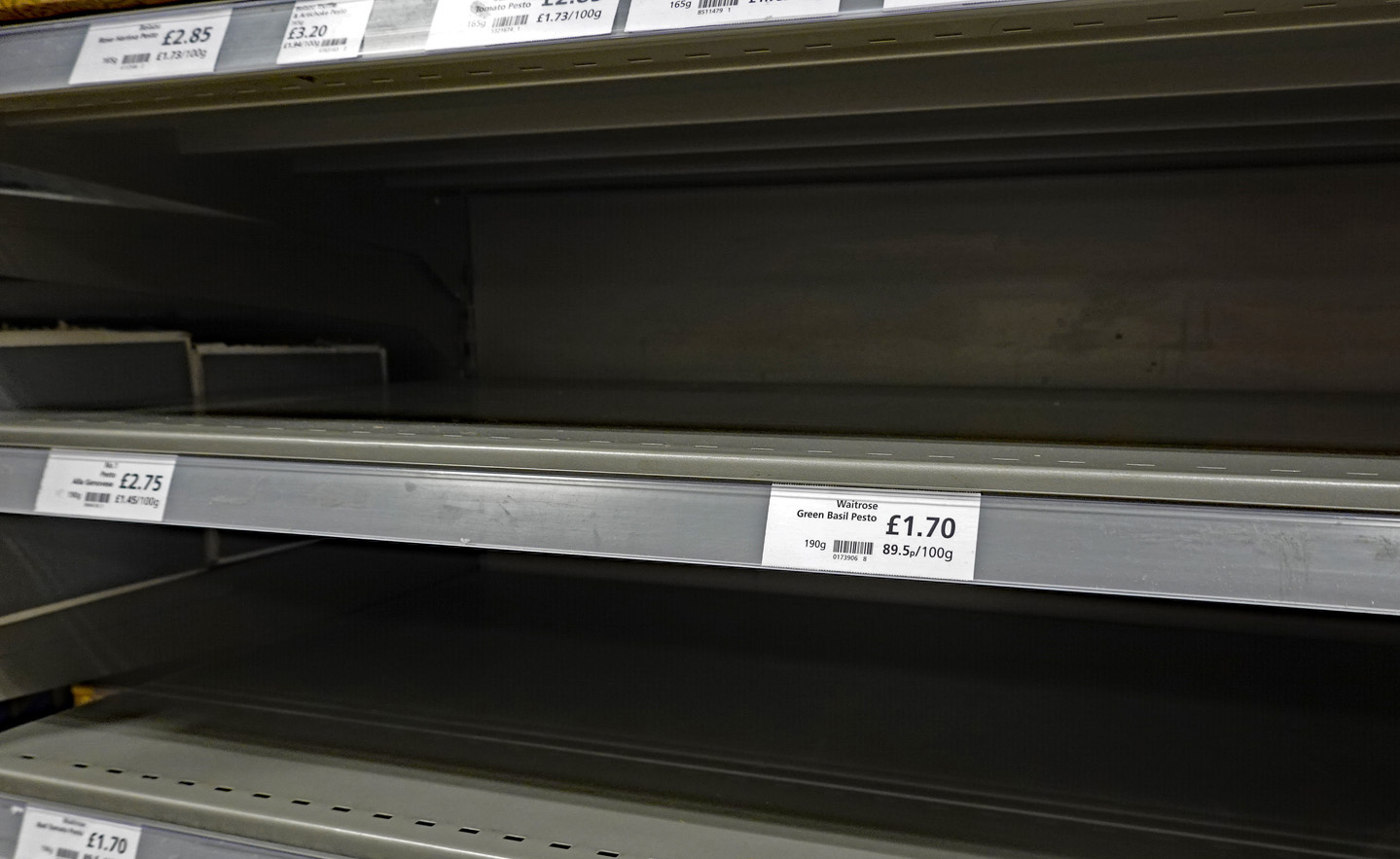 Then there is a decline in the system known as ‘cabotage’. This is where an EU driver delivers from the EU to destination A in the UK and takes back a load to the EU from destination B in the UK. To avoid having to travel empty between the two UK destinations, the driver could pick up a load to take from A to B. With a fall in imports and exports from and to the EU following Brexit, there are fewer EU lorries on UK roads. This means that there is now less capacity for transporting loads within the UK.
Then there is a decline in the system known as ‘cabotage’. This is where an EU driver delivers from the EU to destination A in the UK and takes back a load to the EU from destination B in the UK. To avoid having to travel empty between the two UK destinations, the driver could pick up a load to take from A to B. With a fall in imports and exports from and to the EU following Brexit, there are fewer EU lorries on UK roads. This means that there is now less capacity for transporting loads within the UK.
There has also been a large rise in ‘red tape’ associated with post-Brexit customs checks and border controls. This means that lorries can be held up at ports. This makes it much less attractive for EU haulage companies to export to the UK rather than to other EU countries, where paperwork is minimal. In addition, m many drivers are paid by the length of the journey rather than by the time spent, so delays result in them earning less per hour. Full checks have not been introduced yet. When they are, in January and July next year, the problem will be worse.
Tax changes make it more difficult for drivers to avoid taxes by claiming that they are self employed when they are in reality employees. This too is discouraging drivers from the EU from moving to or staying in the UK since many would now (since April 2021) be paying more tax.
COVID-19
Another contributing factor to the shortage of drivers has been COVID-19 and the government’s response to it. COVID rates are considerably higher in the UK than in most EU countries and, not surprisingly, many EU drivers are afraid to come to the UK.
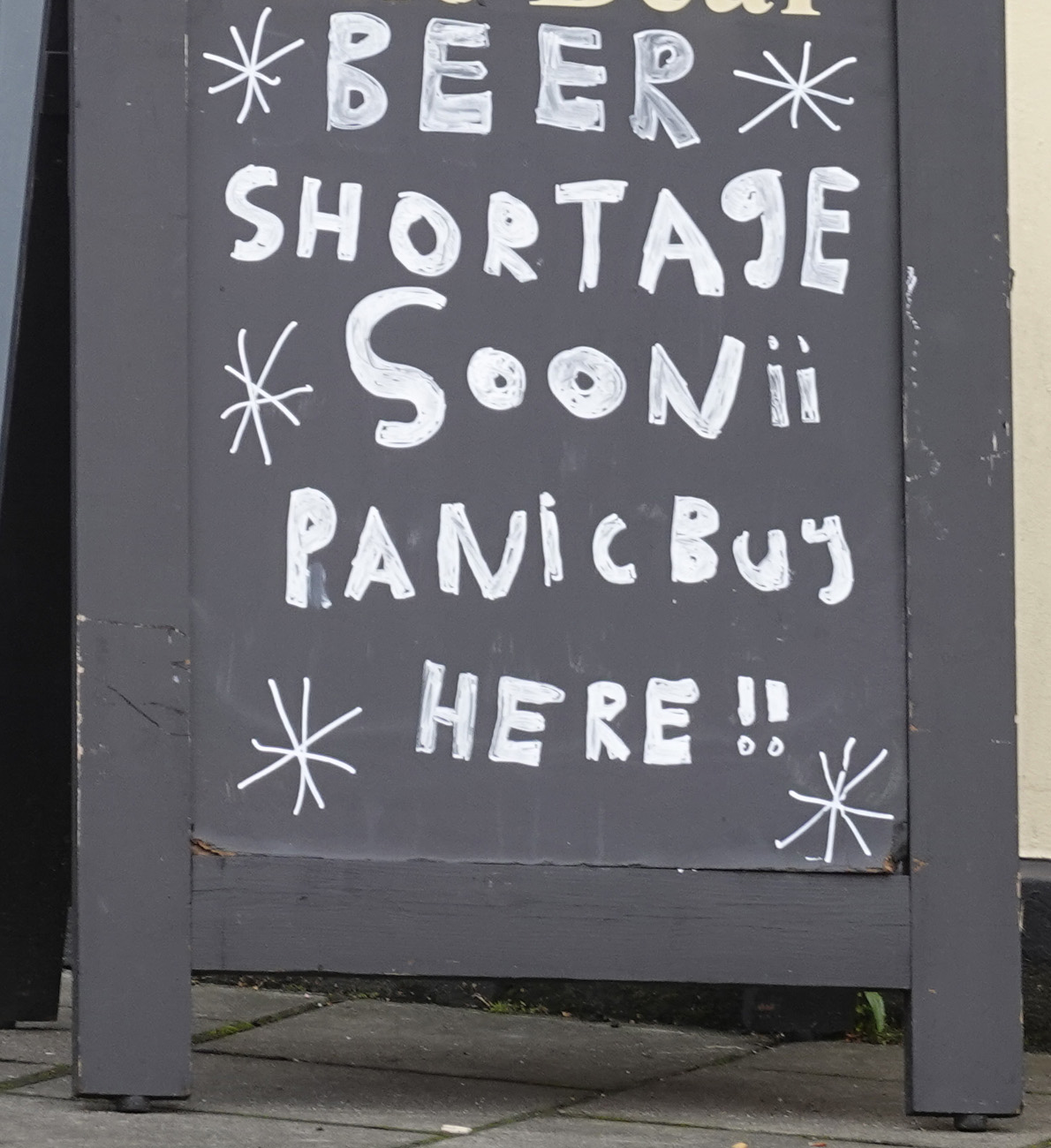 The pandemic led to fewer HGV driver tests, with 25 000 fewer candidates passing their test in 2020 than in 2019. It takes time to train new drivers and then to test them. However, even if there had been no reduction in HGV drivers passing their tests, there would still be a significant shortage of qualified drivers.
The pandemic led to fewer HGV driver tests, with 25 000 fewer candidates passing their test in 2020 than in 2019. It takes time to train new drivers and then to test them. However, even if there had been no reduction in HGV drivers passing their tests, there would still be a significant shortage of qualified drivers.
A further problem with the effects of COVID-19 on the economy has been the initial recession and then the bounce back. The sheer size of the bounce back has exacerbated the problem of driver shortages, which otherwise would have been slower to develop, giving the market more time to respond. Real GDP grew by 5.5% from 2021 Q1 to 2021 Q2, giving an annual growth rate of 23.6%. Nevertheless, GDP was still some 3.3% below its 2019 Q3 level.
Pay and working conditions
Working conditions are very poor for many drivers. The following are common complaints:
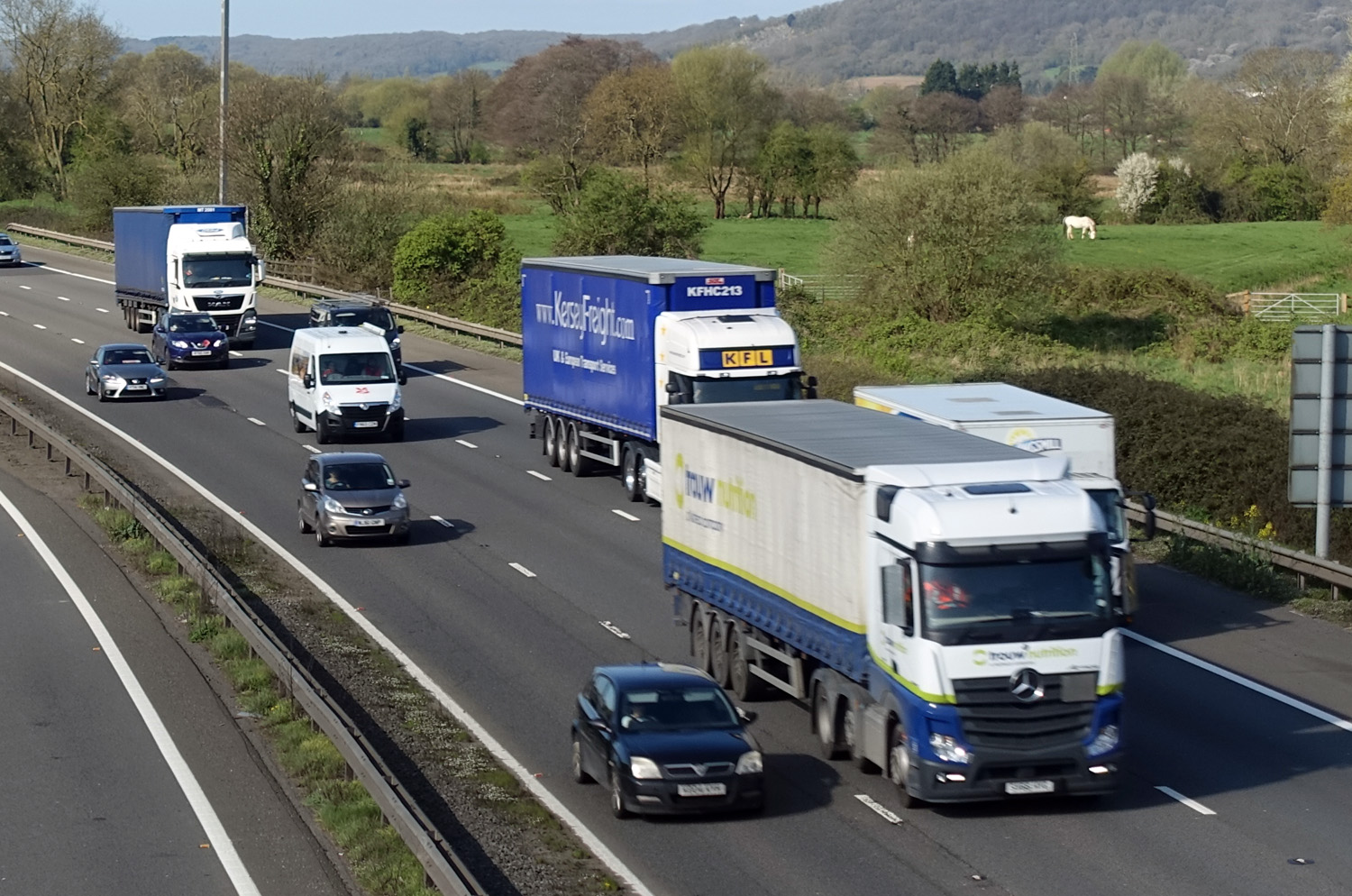 Driving jobs are often very tightly controlled, with computer monitoring and little freedom for the driver. Some cabs have cameras aimed at the drivers so that they can be constantly monitored.
Driving jobs are often very tightly controlled, with computer monitoring and little freedom for the driver. Some cabs have cameras aimed at the drivers so that they can be constantly monitored.- Drivers are subject to very stringent health and safety regulations, such as not being allowed to drive longer than a certain time, even when they are queuing in congested traffic. Whilst many of these regulations are desirable to protect both the public’s and the driver’s safety, they can discourage drivers from entering or staying in the industry. And some regulations are hard to justify on safety grounds (see second linked article below, point 13).
- Just-in-time deliveries at supermarkets, regional distribution centres (warehouses) or factories make timing very important and add considerable stress to drivers who may face abuse if they are late, even though it was not their fault, with their employer perhaps facing a fine. And yet on other occasions they might have to wait a long time to offload if drivers before them have been delayed, and often the conditions in waiting areas are poor with few if any facilities.
- Drivers often feel a lack of respect from employers, trainers and the general public.
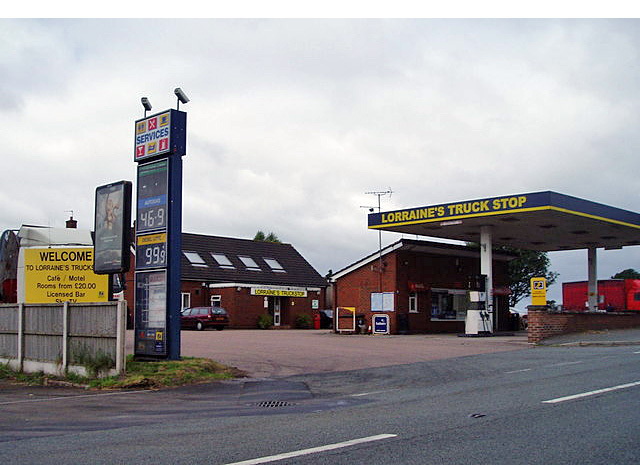 Rest and refreshment facilities are often very poor in the UK and generally much worse than in the EU. In the EU, motorway service areas have better parking, toilets, showers and shops. Restaurants are better and cheaper. Dedicated truck stops have supermarkets, laundrettes, showers or even open-air gyms dedicated to making drivers’ lives easier and more pleasant. The UK by contrast often has very poor facilities. Unlike in most EU motorway services, drivers have to pay to park and are faced with poor toilet and eating facilities. ‘Meanwhile, a typical British truck stop is some dusty yard full of potholes on the side of some industrial estate with a portaloo and a “greasy spoon” burger van parked next to it.’
Rest and refreshment facilities are often very poor in the UK and generally much worse than in the EU. In the EU, motorway service areas have better parking, toilets, showers and shops. Restaurants are better and cheaper. Dedicated truck stops have supermarkets, laundrettes, showers or even open-air gyms dedicated to making drivers’ lives easier and more pleasant. The UK by contrast often has very poor facilities. Unlike in most EU motorway services, drivers have to pay to park and are faced with poor toilet and eating facilities. ‘Meanwhile, a typical British truck stop is some dusty yard full of potholes on the side of some industrial estate with a portaloo and a “greasy spoon” burger van parked next to it.’- Hours are long. Even though driving hours are restricted to 10 hours per day (recently extended to 11 hours), the average working day may be much longer as drivers have to wait at distribution centres, fill in increasing amounts of paperwork and help load or unload their vehicle. Also drivers may have to work variable shifts, which leads to disturbed sleeping patterns.
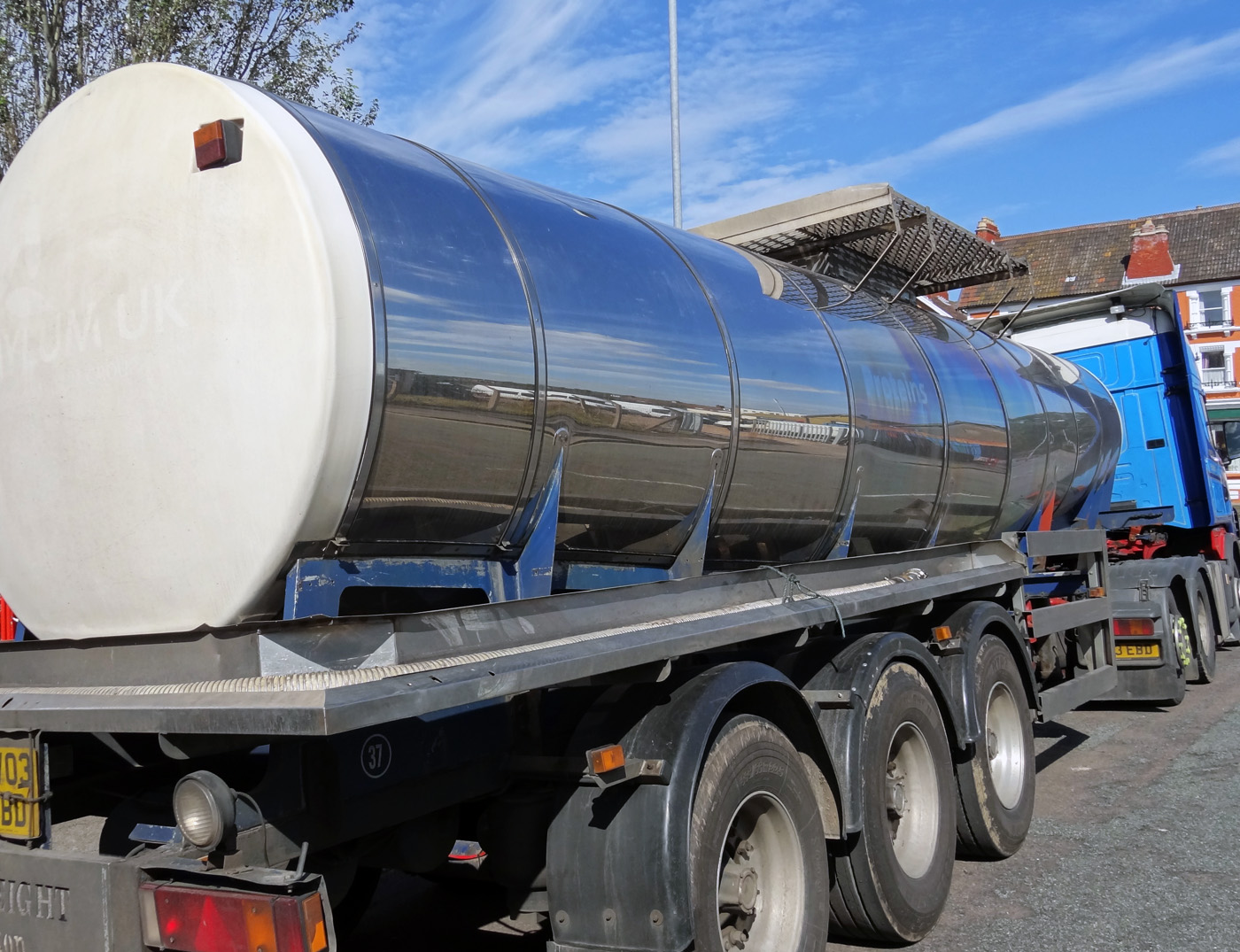 The work is often physically demanding, especially when a large part of the job involves loading and unloading and moving items from the lorry to where the customer wants them.
The work is often physically demanding, especially when a large part of the job involves loading and unloading and moving items from the lorry to where the customer wants them.- Many vehicles are hard and unpleasant to drive, with leased vehicles often low-spec, dirty, uncomfortable and poorly maintained.
- Many of the jobs are agency jobs that do not offer stable employment.
Although pay is higher than in some parts of the labour market where there are shortages, such as social care and hospitality, pay per hour is still relatively poor when compared with many industries which have better conditions of employment.
The future
 The government is allowing more foreign workers into the UK from this month (October); more training places will be offered for potential drivers and the number of driving tests will increase; the government is also encouraging retired drivers or those who have left driving for other jobs to return to the industry.
The government is allowing more foreign workers into the UK from this month (October); more training places will be offered for potential drivers and the number of driving tests will increase; the government is also encouraging retired drivers or those who have left driving for other jobs to return to the industry.
However, there are shortages of drivers in other EU countries and so it will be difficult to attract additional drivers to the UK from the EU. What is more, with wages and working conditions remaining poor and the labour market remaining tight in other sectors, it might be hard to fill new training places and encourage workers to return to driving. Also, with the average age of drivers being 55, it is likely that the outflow of workers from driving jobs could be large in the coming years.
Articles
- Twenty reasons why there is an HGV driver shortage – part one: 1-10
West Country Bylines, Tomasz Oryński (21/9/21)
- Twenty reasons why there is an HGV driver shortage – part 2: reasons 11-20
West Country Bylines, Tomasz Oryński (23/9/21)
- Gas Shortages Awaken Britain to Some Crucial Workers: Truck Drivers
New York Times, Eshe Nelson and Megan Specia (29/9/21)
- Time running out to save UK industry from worker shortages, say business leaders
CNN, Walé Azeez (1/10/21)
- Boris Johnson’s Brexit choices are making Britain’s fuel and food shortages worse
CNN, Hanna Ziady (29/9/21)
- How serious is the shortage of lorry drivers?
BBC News, Reality Check Team (28/9/21)
- Petrol shortage: Is the fuel crisis improving?
BBC News (1/10/21)
- UK visa plan will not fix lorry driver shortage, says boss
BBC News (28/9/21)
- The empty shelves crisis isn’t just down to Covid and Brexit – it’s been decades in the making
The Guardian, Felicity Lawrence (17/9/21)
- Emergency visa scheme extended in major U-turn by Boris Johnson
The Guardian, Rajeev Syal (1/10/21)
- Truck driver shortage won’t be solved by quick fix visas – here are three ways forward
The Conversation, Temidayo Akenroye (27/9/21)
- UK lorry driver shortage a stark example of a wider European problem
Euronews, Luke Hurst and Shona Murray (29/9/21)
- Emergency visas won’t tempt European lorry drivers to UK, say haulage chiefs
The Observer, Jon Henley, Michael Savage and James Tapper (25/9/21)
- Labour shortage threatens to cancel out any Brexit dividend
British Meat Processors Association, Industry News, Peter Hardwick (28/9/21)
- How to control a consumer panic
BBC News. Faisal Islam (28/9/21)
Questions
- Why are the supply of and demand for lorry drivers relatively wage inelastic?
- Use a marginal productivity diagram to explain the current situation in the market for lorry drivers.
- What policy measures could be adopted to increase the supply of lorry drivers? How successful would these be?
- Is it ‘rational’ for consumers to ‘panic buy’ fuel and other products in short supply?
- Find out why there is a shortage of lorry drivers in the EU. Are any of the explanations similar to those in the UK?
- What are the macroeconomic implications of a shortage of lorry drivers and other key workers?
 The effects of the Brexit trade deal are becoming clearer as new data are released. Figures for UK food imports and exports from and to the EU for the first quarter of 2021 have been published by the Food and Drink Federation. These show a 46.6% fall in UK food and drink exports to the EU in Q1 2021 when compared with Q1 2020, and a 55.1% fall when compared with Q1 2019 (before COVID).
The effects of the Brexit trade deal are becoming clearer as new data are released. Figures for UK food imports and exports from and to the EU for the first quarter of 2021 have been published by the Food and Drink Federation. These show a 46.6% fall in UK food and drink exports to the EU in Q1 2021 when compared with Q1 2020, and a 55.1% fall when compared with Q1 2019 (before COVID).
The dairy sector has been the hardest hit, with exports of milk and cream to the EU down by more than 90% and exports of cheese down by 67% compared with Q1 2020. Other hard-hit sectors have been soft drinks, fish, potatoes and chicken. (Click here for a PowerPoint of the following chart.)
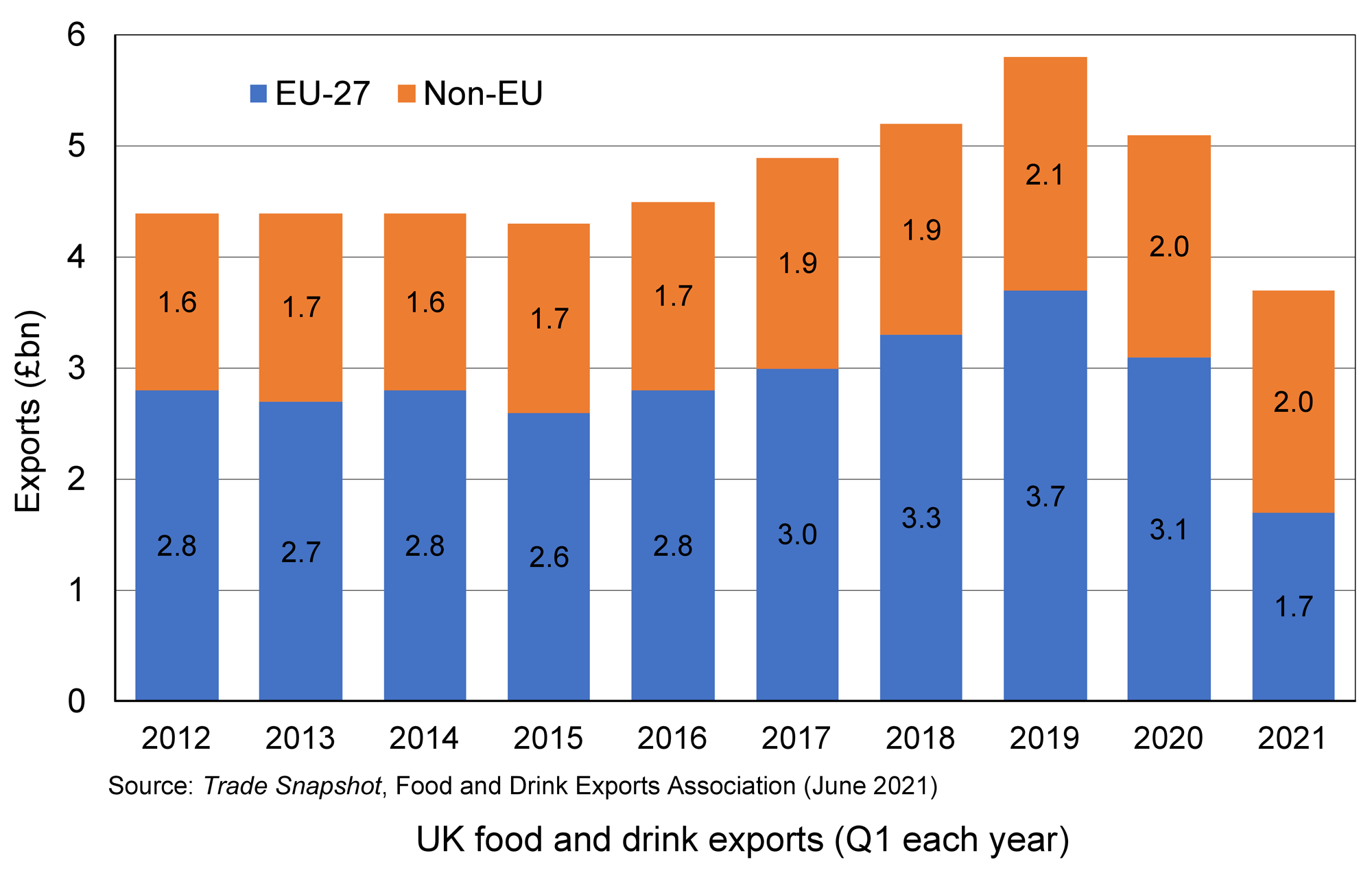
The Brexit trade deal did not involve the imposition of tariffs on exports and imports. However, with the UK having left the EU single market, there are now many regulatory checks and a considerable amount of paperwork to be completed for each consignment of exports. These frictions are slowing down trade and adding to costs. Although food and drink exports are beginning to recover somewhat, the delays while formalities are completed will have a lasting dampening effect on exports to the EU, especially in the case of perishable goods, such as meat and fish.
Also, farming has been badly affected by labour shortages, with many EU citizens returning to the EU. For example, according to the British Poultry Council (BPC), 10 per cent fewer chickens had been produced since Easter because of worker shortages. Across meat processing generally, similar shortfalls are being recorded because of a lack of labour.
Articles
Questions
- Find out how exports to the EU from sectors other than food and drink have fared since January this year.
- What are rules of origin? Why are they less likely to apply to food exports to the EU than to manufactured exports?
- Would you describe the Brexit trade deal (the EU-UK Trade and Cooperation Agreement) as a ‘free-trade’ deal? Explain.
- What are the particular difficulties for the food and drink sector in the Trade and Cooperation Agreement?
- Find out which parts of the food and drink sector have been particularly affected by labour shortages.
 The OECD has recently published its six-monthly Economic Outlook. This assesses the global economic situation and the prospects for the 38 members of the OECD.
The OECD has recently published its six-monthly Economic Outlook. This assesses the global economic situation and the prospects for the 38 members of the OECD.
It forecasts that the UK economy will bounce back strongly from the deep recession of 2020, when the economy contracted by 9.8 per cent. This contraction was deeper than in most countries, with the USA contracting by 3.5 per cent, Germany by 5.1 per cent, France by 8.2 per cent, Japan by 4.7 per cent and the OECD as a whole by 4.8 per cent. But, with the success of the vaccine roll-out, UK growth in 2021 is forecast by the OECD to be 7.2 per cent, which is higher than in most other countries. The USA is forecast to grow by 6.8 per cent, Germany by 3.3 per cent, France by 5.8 per cent, Japan by 2.6 per cent and the OECD as a whole by 5.3 per cent. Table 1 in the Statistical Annex gives the figures.
This good news for the UK, however, is tempered by some worrying features.
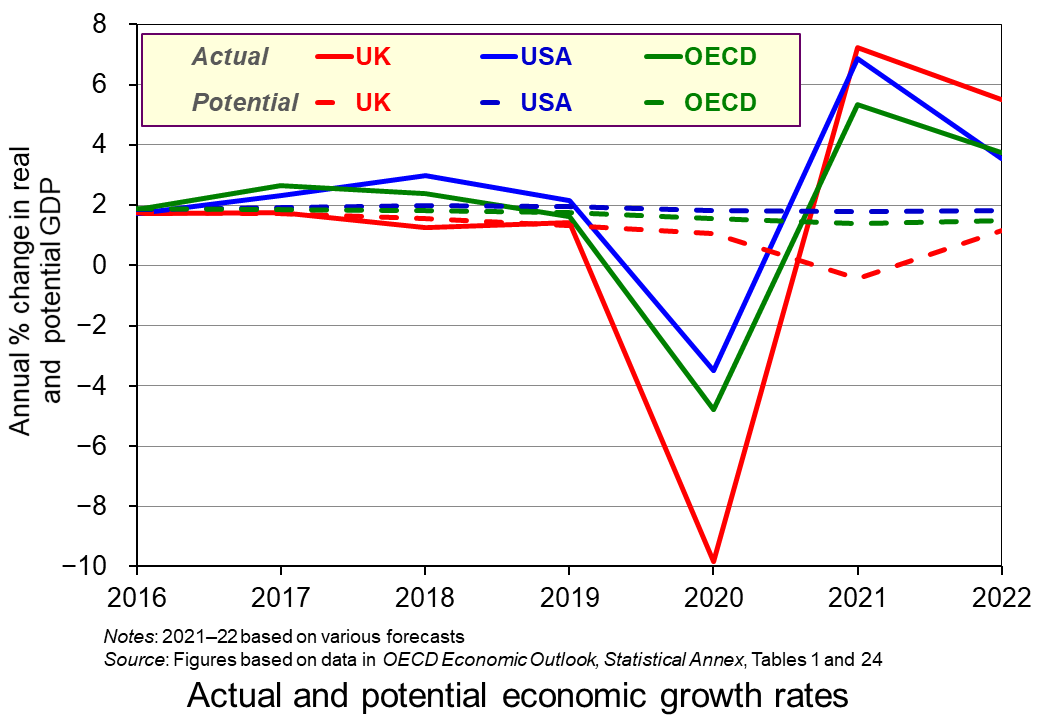 The OECD forecasts that potential economic growth will be negative in 2021, with capacity declining by 0.4 per cent. Only two other OECD countries, Italy and Greece, are forecast to have negative potential economic growth (see Table 24 in the Statistical Annex). A rapid increase in aggregate demand, accompanied by a decline in aggregate supply, could result in inflationary pressures, even if initially there is considerable slack in some parts of the economy.
The OECD forecasts that potential economic growth will be negative in 2021, with capacity declining by 0.4 per cent. Only two other OECD countries, Italy and Greece, are forecast to have negative potential economic growth (see Table 24 in the Statistical Annex). A rapid increase in aggregate demand, accompanied by a decline in aggregate supply, could result in inflationary pressures, even if initially there is considerable slack in some parts of the economy.
Part of the reason for the supply constraints are the additional barriers to trade with the EU resulting from Brexit. The extra paperwork for exporters has added to export costs, and rules-of-origin regulations add tariffs to many exports to the EU (see the blog A free-trade deal? Not really). Another supply constraint linked to Brexit is the shortage of labour in certain sectors, such as hospitality, construction and transport. With many EU citizens having left the UK and not being replaced by equivalent numbers of new immigrants, the problem is likely to persist.
 The scarring effects of the pandemic present another problem. There has been a decline in investment. Even if this is only temporary, it will have a long-term impact on capacity, unless there is a compensating rise in investment in the future. Many businesses have closed and will not re-open, including many High Street stores. Moves to working from home, even if partially reversed as the economy unlocks, will have effects on the public transport industry. Also, people may have found new patterns of consumption, such as making more things for themselves rather than buying them, which could affect many industries. It is too early to predict the extent of these scarring effects and how permanent they will be, but they could have a dampening effect on certain sectors.
The scarring effects of the pandemic present another problem. There has been a decline in investment. Even if this is only temporary, it will have a long-term impact on capacity, unless there is a compensating rise in investment in the future. Many businesses have closed and will not re-open, including many High Street stores. Moves to working from home, even if partially reversed as the economy unlocks, will have effects on the public transport industry. Also, people may have found new patterns of consumption, such as making more things for themselves rather than buying them, which could affect many industries. It is too early to predict the extent of these scarring effects and how permanent they will be, but they could have a dampening effect on certain sectors.
Inflation
So will inflation take off, or will it remain subdued? At first sight it would seem that inflation is set to rise significantly. Annual CPI inflation rose from 0.7 per cent in March 2021 to 1.5 per cent in April, with the CPI rising by 0.6 per cent in April alone. What is more, the housing market has seen a large rise in demand, with annual house price inflation reaching 10.2 per cent in March.
But these rises have been driven by some one-off events. As the economy began unlocking, so spending rose dramatically. While this may continue for a few months, it may not persist, as an initial rise in household spending may reflect pent-up demand and as the furlough scheme comes to an end in September.
 As far as as the housing market is concerned, the rise in demand has been fuelled by the stamp duty ‘holiday’ which exempts residential property purchase from Stamp Duty Land Tax for properties under £500 000 in England and Northern Ireland and £250 000 in Scotland and Wales (rather than the original £125 000 in England and Northern Ireland, £145 000 in Scotland and £180 000 in Wales). In England and Northern Ireland, this limit is due to reduce to £250 000 on 30 June and back to £125 000 on 30 September. In Scotland the holiday ended on 31 March and in Wales is due to end on 30 June. As these deadlines are passed, this should see a significant cooling of demand.
As far as as the housing market is concerned, the rise in demand has been fuelled by the stamp duty ‘holiday’ which exempts residential property purchase from Stamp Duty Land Tax for properties under £500 000 in England and Northern Ireland and £250 000 in Scotland and Wales (rather than the original £125 000 in England and Northern Ireland, £145 000 in Scotland and £180 000 in Wales). In England and Northern Ireland, this limit is due to reduce to £250 000 on 30 June and back to £125 000 on 30 September. In Scotland the holiday ended on 31 March and in Wales is due to end on 30 June. As these deadlines are passed, this should see a significant cooling of demand.
Finally, although the gap between potential and actual output is narrowing, there is still a gap. According to the OECD (Table 12) the output gap in 2021 is forecast to be −4.6 per cent. Although it was −11.4 per cent in 2020, a gap of −4.6 per cent still represents a significant degree of slack in the economy.
At the current point in time, therefore, the Bank of England does not expect to have to raise interest rates in the immediate future. But it stands ready to do so if inflation does show signs of taking off.
Articles
- United Kingdom Economic Snapshot
OECD Economic Outlook (May 2021)
- UK growth forecast upgraded but pandemic economic ‘scar’ will be worst of all G7 nations, says OECD
Sky News, Ed Conway (31/5/21)
- OECD Predicts UK Economic Growth Amid Vaccine Success And Lockdown Easing
Minutehack Emma Bowden (1/6/21)
- UK growth upgraded, but OECD warns of deepest economic scar in G7
The Guardian, Graeme Wearden (31/5/21)
- UK set for stronger post-Covid recovery, says OECD
BBC News (31/5/21)
- British exports worth billions have faced EU tariffs since Brexit
BBC News, Faisal Islam (28/5/21)
 Post-Brexit: Businesses hit by labour shortages call for Brexit rules to be relaxed
Post-Brexit: Businesses hit by labour shortages call for Brexit rules to be relaxedChannel 4 News, Paul McNamara (2/6/21)
- Bank of England monitors UK housing boom as it weighs inflation risk
The Guardian, Larry Elliott (1/6/21)
- House prices jump 10.9% as ‘race for space’ intensifies
BBC News (1/6/21)
- Global food prices post biggest jump in decade
Financial Times, Emiko Terazono and Judith Evans (3/6/21)
- Why house prices are rising so fast in a pandemic
BBC News, Kevin Peachey and Daniele Palumbo (2/6/21)
- Inflation: why it could surge after the pandemic
The Conversation, Ian Crowther (23/4/21)
- Inflation might well keep rising in 2021 – but what happens after that?
The Conversation, Brigitte Granville (31/5/21)
- Slack in the Economy, Not Inflation, Should Be Bigger Worry
Institute for New Economic Thinking, Claudia Fontanari, Antonella Palumbo, and Chiara Salvatori (19/5/21)
Data, Forecasts and Analysis
Questions
- What determines the rate of (a) actual economic growth; (b) potential economic growth?
- What is meant by an output gap? What would be the implications of a positive output gap?
- Why are scarring effects of the pandemic likely to be greater in the UK than in most other countries?
- If people believed that inflation was likely to continue rising, how would this affect their behaviour and how would it affect the economy?
- What are the arguments for and against having a stamp duty holiday when the economy is in recession?
 At 23:00 on 31 December 2020, the UK withdrew from the European single market. This ended the transition period which followed the UK’s departure from the EU on 31 January 2020. But, with the Trade and Cooperation Agreement (‘the deal’) signed on 30 December, it was agreed that there would be no tariffs or quotas on trade in goods between the UK and the EU.
At 23:00 on 31 December 2020, the UK withdrew from the European single market. This ended the transition period which followed the UK’s departure from the EU on 31 January 2020. But, with the Trade and Cooperation Agreement (‘the deal’) signed on 30 December, it was agreed that there would be no tariffs or quotas on trade in goods between the UK and the EU.
So what are the new economic relations between the EU and the UK and how will they impact on the UK economy? What new restrictions are there on trade in goods and on the movement of labour and capital? How is trade in services, including financial services, affected? What new agreements, such as on fishing, will replace previous agreements?
What will happen to trade between Northern Ireland and the Republic of Ireland? What will happen to trade between Great Britain and Northern Ireland?
 What will happen to regulations over standards of traded products and their production? Will the UK government be able to provide subsidies or other types of support for goods or services exported to the EU? How will disputes about standards and support to companies be resolved?
What will happen to regulations over standards of traded products and their production? Will the UK government be able to provide subsidies or other types of support for goods or services exported to the EU? How will disputes about standards and support to companies be resolved?
How will trade with non-EU countries change? If the EU has trade agreements with such countries, do these agreements now apply to trade between the UK and such countries? How free is the UK now to negotiate new trade agreements with non-EU countries? How will the UK’s negotiating strength be affected by its withdrawal from the EU?
Rather than listing the changes here, follow the links below to the articles and assess the nature of the changes and then attempt the questions. The articles represent a balance of views.
What is clear is that these are all big issues and are likely to have a significant impact on the UK economy. Most economists argue that the net effect will be negative on trade and economic growth, but there is huge uncertainty about the magnitude of the effects. Much will depend on how arrangements between the UK and the EU develop over the coming months and years.
Articles
 Brexit deal explained: What will be the impact of UK’s agreement with EU?
Brexit deal explained: What will be the impact of UK’s agreement with EU?Sky News, Ed Conway (24/12/20)
- Brexit deal: What is in it?
BBC News, Chris Morris (28/12/20)
- Brexit: What are the key points of the deal?
BBC News, Tom Edgington (30/12/20)
- Brexit trade deal explained: the key parts of the landmark agreement
Financial Times (25/12/20)
- The key details of the Brexit deal summarised, from trade to fishing
The Telegraph, James Crisp and Gordon Rayner (3/1/21)
- Committees, visas and climate change: Brexit experts’ verdicts on the deal details
The Guardian, Lisa O’Carroll (28/12/20)
- The left must stop mourning Brexit – and start seeing its huge potential
The Guardian, Larry Elliott (31/12/20)
- The Guardian view on Britain out of the EU: a treasure island for rentiers
The Guardian, Editorial (27/12/20)
- Brexit Is Finally Done, but It Already Seems Out of Date
New York Times, Mark Landler (30/12/20)
- Towards a modern UK-EU trade relationship
Best for Britain, David Henig (28/12/20)
- Brexit Is a New World Businesses Still Need to Figure Out
Bloomberg, Deirdre Hipwell, Craig Trudell, and Dara Doyle (1/1/21)
UK and EU documents
Questions
- Summarise the main features of the Trade and Cooperation Agreement and how the UK’s new relationship with the EU differs from being a member.
- What are the potential economic benefits from being outside the EU?
- What are the economic drawbacks for the UK from having left the EU, albeit with the new Trade and Cooperation Agreement?
- On balance, do you think that the UK will gain or lose economically from having left the EU? Explain your answer.
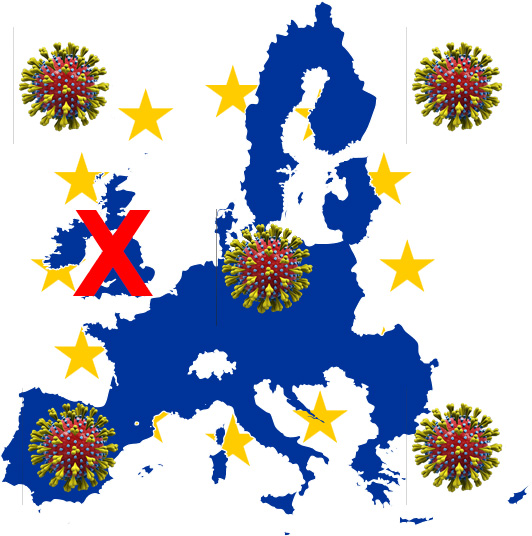 The LSE’s Centre for Economic Performance has just published a paper looking at the joint impact of Covid-19 and Brexit on the UK economy. Apart from the short-term shocks, both will have a long-term dampening effect on the UK economy. But they will largely affect different sectors.
The LSE’s Centre for Economic Performance has just published a paper looking at the joint impact of Covid-19 and Brexit on the UK economy. Apart from the short-term shocks, both will have a long-term dampening effect on the UK economy. But they will largely affect different sectors.
Covid-19 has affected, and will continue to affect, direct consumer-facing industries, such as shops, the hospitality and leisure industries, public transport and personal services. Brexit will tend to hit those industries most directly involved in trade with Europe, the UK’s biggest trading partner. These industries include manufacturing, financial services, posts and telecommunications, mining and quarrying, and agriculture and fishing.
Despite the fact that largely different sectors will be hit by these two events, the total effect may be greater than from each individually. One of the main reasons for this is the dampening impact of Covid-19 on globalisation. 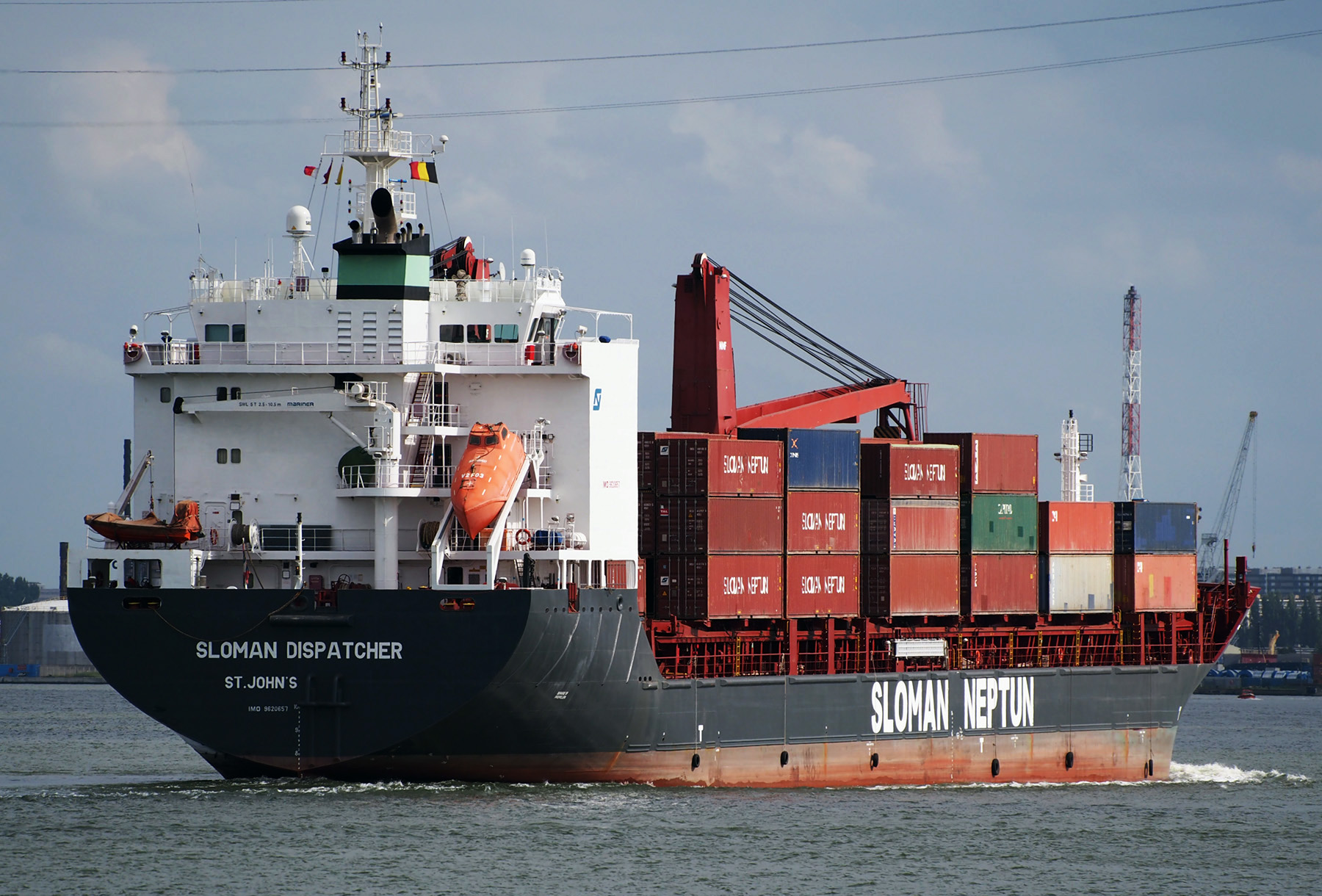 Travel restrictions are likely to remain tighter to more distant countries. And countries are likely to focus on trading within continents or regions rather than the whole world. For the UK, this, other things being equal, would mean an expansion of trade with the EU relative to the rest of the world. But, unless there is a comprehensive free-trade deal with the EU, the UK would not be set to take full advantage of this trend.
Travel restrictions are likely to remain tighter to more distant countries. And countries are likely to focus on trading within continents or regions rather than the whole world. For the UK, this, other things being equal, would mean an expansion of trade with the EU relative to the rest of the world. But, unless there is a comprehensive free-trade deal with the EU, the UK would not be set to take full advantage of this trend.
Another problem is that the effects of the Covid-19 pandemic have weakened the economy’s ability to cope with further shocks, such as those from Brexit. Depending on the nature (or absence) of a trade deal, Brexit will impose higher burdens on trading companies, including meeting divergent standards and higher administrative costs from greater form filling, inspections and customs delays.
Papers
Articles
Questions
- Referring to the LSE paper, give some examples of industries that are likely to be particularly hard hit by Brexit when the transition period ends? Explain why.
- Why have university finances been particularly badly affected by both Covid-19 and Brexit? Are there any other sectors that have suffered (or will suffer) badly from both events?
- Is there a scenario where globalisation in trade could start to grow again?
- Has Covid-19 affected countries’ comparative advantage in particular products traded with particular countries and, if so, how?
- The authors of the LSE report argue that ‘government policies to stimulate demand, support workers to remain in employment or find new employment, and to support businesses remain essential’. How realistic is it to expect the government to provide additional support to businesses and workers to deal with the shock of Brexit?
 Long queues at petrol pumps, with many filling stations running out of fuel; fears of shortages of food and various other items in supermarkets; orders by shops and warehouses unfilled or delayed. These have been some of the headlines in the UK in recent days.
Long queues at petrol pumps, with many filling stations running out of fuel; fears of shortages of food and various other items in supermarkets; orders by shops and warehouses unfilled or delayed. These have been some of the headlines in the UK in recent days.  With Brexit, many EU workers left the UK, finding life and working conditions more conducive in the EU. Many EU drivers had faced discrimination and felt that they were not welcome in the UK. It has been difficult finding replacement drivers from the EU as the UK’s immigration system, which now applies to the EU as well as other countries, prioritises workers who are classified as high-skilled, and these do not include lorry drivers.
With Brexit, many EU workers left the UK, finding life and working conditions more conducive in the EU. Many EU drivers had faced discrimination and felt that they were not welcome in the UK. It has been difficult finding replacement drivers from the EU as the UK’s immigration system, which now applies to the EU as well as other countries, prioritises workers who are classified as high-skilled, and these do not include lorry drivers. Then there is a decline in the system known as ‘cabotage’. This is where an EU driver delivers from the EU to destination A in the UK and takes back a load to the EU from destination B in the UK. To avoid having to travel empty between the two UK destinations, the driver could pick up a load to take from A to B. With a fall in imports and exports from and to the EU following Brexit, there are fewer EU lorries on UK roads. This means that there is now less capacity for transporting loads within the UK.
Then there is a decline in the system known as ‘cabotage’. This is where an EU driver delivers from the EU to destination A in the UK and takes back a load to the EU from destination B in the UK. To avoid having to travel empty between the two UK destinations, the driver could pick up a load to take from A to B. With a fall in imports and exports from and to the EU following Brexit, there are fewer EU lorries on UK roads. This means that there is now less capacity for transporting loads within the UK. The pandemic led to fewer HGV driver tests, with 25 000 fewer candidates passing their test in 2020 than in 2019. It takes time to train new drivers and then to test them. However, even if there had been no reduction in HGV drivers passing their tests, there would still be a significant shortage of qualified drivers.
The pandemic led to fewer HGV driver tests, with 25 000 fewer candidates passing their test in 2020 than in 2019. It takes time to train new drivers and then to test them. However, even if there had been no reduction in HGV drivers passing their tests, there would still be a significant shortage of qualified drivers. Driving jobs are often very tightly controlled, with computer monitoring and little freedom for the driver. Some cabs have cameras aimed at the drivers so that they can be constantly monitored.
Driving jobs are often very tightly controlled, with computer monitoring and little freedom for the driver. Some cabs have cameras aimed at the drivers so that they can be constantly monitored. Rest and refreshment facilities are often very poor in the UK and generally much worse than in the EU. In the EU, motorway service areas have better parking, toilets, showers and shops. Restaurants are better and cheaper. Dedicated truck stops have supermarkets, laundrettes, showers or even open-air gyms dedicated to making drivers’ lives easier and more pleasant. The UK by contrast often has very poor facilities. Unlike in most EU motorway services, drivers have to pay to park and are faced with poor toilet and eating facilities. ‘Meanwhile, a typical British truck stop is some dusty yard full of potholes on the side of some industrial estate with a portaloo and a “greasy spoon” burger van parked next to it.’
Rest and refreshment facilities are often very poor in the UK and generally much worse than in the EU. In the EU, motorway service areas have better parking, toilets, showers and shops. Restaurants are better and cheaper. Dedicated truck stops have supermarkets, laundrettes, showers or even open-air gyms dedicated to making drivers’ lives easier and more pleasant. The UK by contrast often has very poor facilities. Unlike in most EU motorway services, drivers have to pay to park and are faced with poor toilet and eating facilities. ‘Meanwhile, a typical British truck stop is some dusty yard full of potholes on the side of some industrial estate with a portaloo and a “greasy spoon” burger van parked next to it.’ The work is often physically demanding, especially when a large part of the job involves loading and unloading and moving items from the lorry to where the customer wants them.
The work is often physically demanding, especially when a large part of the job involves loading and unloading and moving items from the lorry to where the customer wants them. The government is allowing more foreign workers into the UK from this month (October); more training places will be offered for potential drivers and the number of driving tests will increase; the government is also encouraging retired drivers or those who have left driving for other jobs to return to the industry.
The government is allowing more foreign workers into the UK from this month (October); more training places will be offered for potential drivers and the number of driving tests will increase; the government is also encouraging retired drivers or those who have left driving for other jobs to return to the industry.  The effects of the
The effects of the 
 The OECD has recently published its six-monthly
The OECD has recently published its six-monthly  The OECD forecasts that potential economic growth will be negative in 2021, with capacity declining by 0.4 per cent. Only two other OECD countries, Italy and Greece, are forecast to have negative potential economic growth (see Table 24 in the Statistical Annex). A rapid increase in aggregate demand, accompanied by a decline in aggregate supply, could result in inflationary pressures, even if initially there is considerable slack in some parts of the economy.
The OECD forecasts that potential economic growth will be negative in 2021, with capacity declining by 0.4 per cent. Only two other OECD countries, Italy and Greece, are forecast to have negative potential economic growth (see Table 24 in the Statistical Annex). A rapid increase in aggregate demand, accompanied by a decline in aggregate supply, could result in inflationary pressures, even if initially there is considerable slack in some parts of the economy. The scarring effects of the pandemic present another problem. There has been a decline in investment. Even if this is only temporary, it will have a long-term impact on capacity, unless there is a compensating rise in investment in the future. Many businesses have closed and will not re-open, including many High Street stores. Moves to working from home, even if partially reversed as the economy unlocks, will have effects on the public transport industry. Also, people may have found new patterns of consumption, such as making more things for themselves rather than buying them, which could affect many industries. It is too early to predict the extent of these scarring effects and how permanent they will be, but they could have a dampening effect on certain sectors.
The scarring effects of the pandemic present another problem. There has been a decline in investment. Even if this is only temporary, it will have a long-term impact on capacity, unless there is a compensating rise in investment in the future. Many businesses have closed and will not re-open, including many High Street stores. Moves to working from home, even if partially reversed as the economy unlocks, will have effects on the public transport industry. Also, people may have found new patterns of consumption, such as making more things for themselves rather than buying them, which could affect many industries. It is too early to predict the extent of these scarring effects and how permanent they will be, but they could have a dampening effect on certain sectors. As far as as the housing market is concerned, the rise in demand has been fuelled by the
As far as as the housing market is concerned, the rise in demand has been fuelled by the 
 What will happen to regulations over standards of traded products and their production? Will the UK government be able to provide subsidies or other types of support for goods or services exported to the EU? How will disputes about standards and support to companies be resolved?
What will happen to regulations over standards of traded products and their production? Will the UK government be able to provide subsidies or other types of support for goods or services exported to the EU? How will disputes about standards and support to companies be resolved? The LSE’s Centre for Economic Performance has just
The LSE’s Centre for Economic Performance has just  Travel restrictions are likely to remain tighter to more distant countries. And countries are likely to focus on trading within continents or regions rather than the whole world. For the UK, this, other things being equal, would mean an expansion of trade with the EU relative to the rest of the world. But, unless there is a comprehensive free-trade deal with the EU, the UK would not be set to take full advantage of this trend.
Travel restrictions are likely to remain tighter to more distant countries. And countries are likely to focus on trading within continents or regions rather than the whole world. For the UK, this, other things being equal, would mean an expansion of trade with the EU relative to the rest of the world. But, unless there is a comprehensive free-trade deal with the EU, the UK would not be set to take full advantage of this trend.